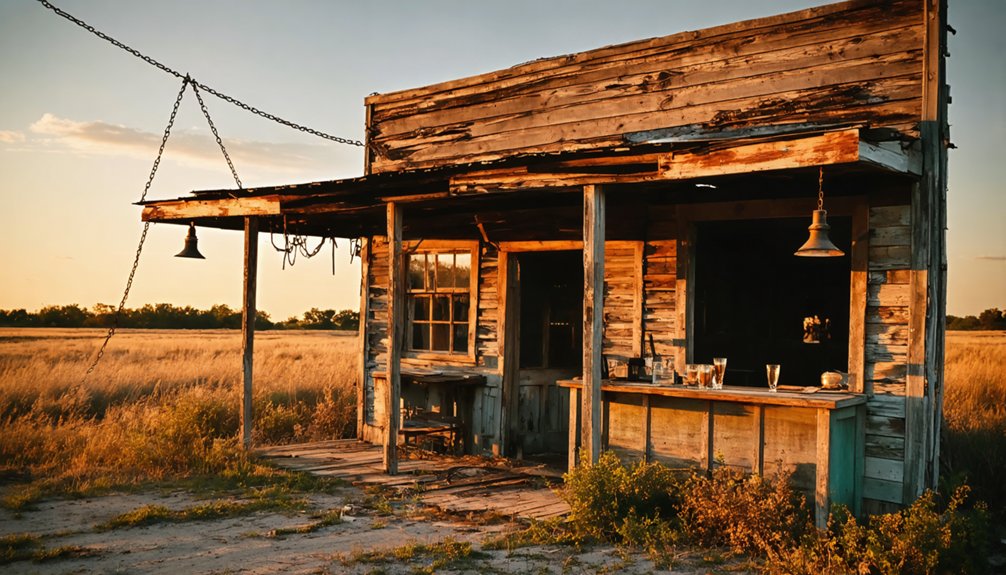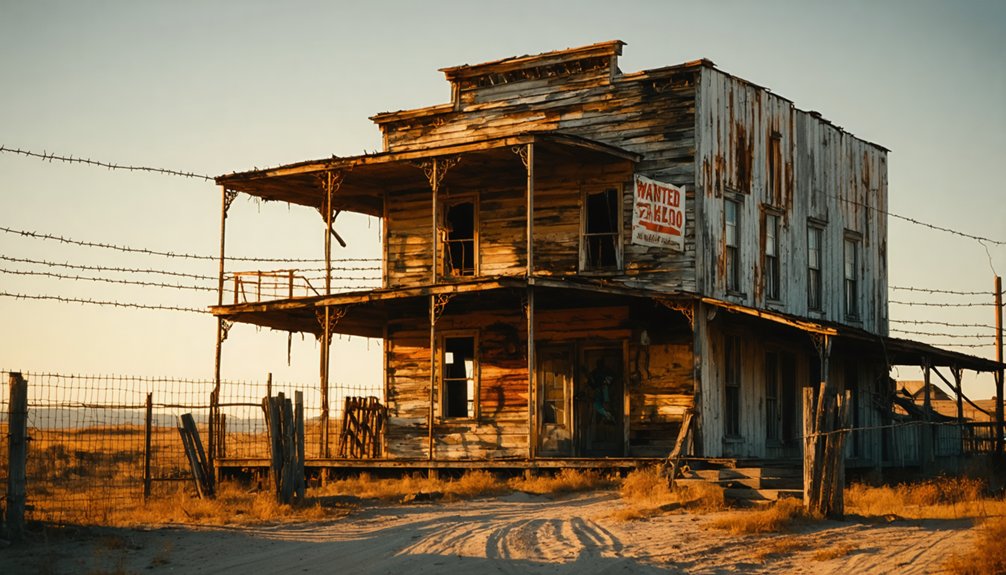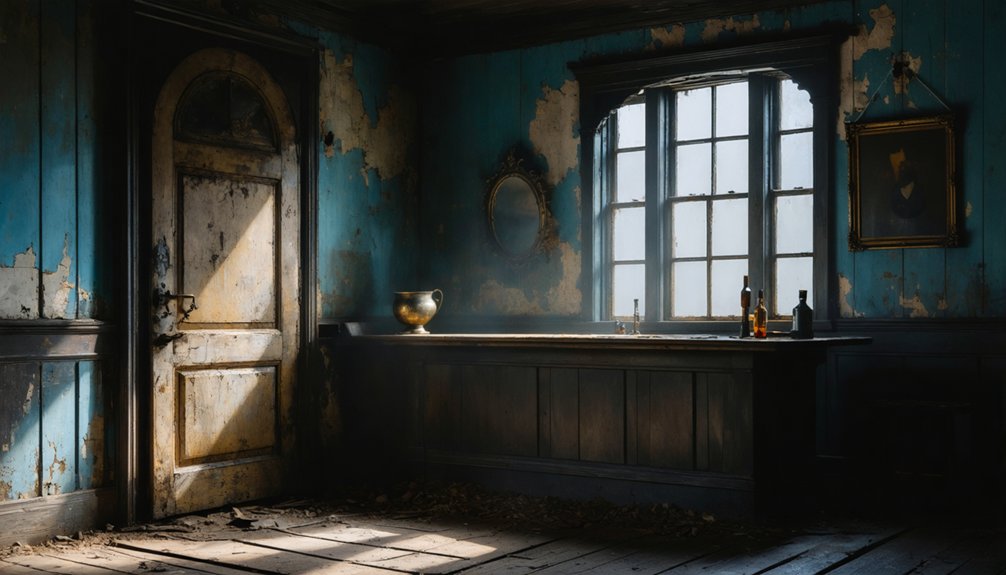Montana’s eeriest haunted mining camps include Garnet Ghost Town, Virginia City, Bannack, Butte, Elkhorn Mine, Granite, and the Smith Mine. You’ll encounter spectral miners who died in disasters like the 1917 Butte fire or the 1943 Smith catastrophe that claimed 74 lives. Cold spots, shadowy figures, and phantom pickaxe sounds permeate these abandoned sites. The whispers of 2,500 lost souls await as you explore Montana’s tragic mining legacy.
Key Takeaways
- Garnet Ghost Town became abandoned after a 1912 fire, with spectral residents reportedly still inhabiting its preserved ruins.
- The Smith Mine disaster site in Bearcreek harbors spirits of 74 miners who left final messages after the 1943 catastrophe.
- Bannack State Park, Montana’s first territorial capital, features ghost tours highlighting paranormal activity in its historic structures.
- Virginia City’s mining history includes reports of ghostly apparitions in saloons, hotels, and abandoned mineshafts throughout town.
- Elkhorn’s haunted cemetery contains spirits of diphtheria-stricken children, contributing to the town’s reputation for paranormal phenomena.
Garnet Ghost Town: Whispers From Montana’s “Mystery Camp”
While gold miners first panned the streams of the Garnet Mountain Range in the 1860s, the town of Garnet itself didn’t take shape until the mid-1890s.
Dr. Armistead Mitchell erected a stamp mill at First Chance Gulch in 1895, with Sam Ritchey’s Nancy Hanks mine becoming the district’s richest producer. The mine produced approximately $300,000 worth of gold during its operation.
By 1898, you’d have found yourself among 1,000 residents in this booming settlement, complete with saloons, a school, and surprisingly little crime.
Unlike many mining towns of the era, Garnet thrived as a peaceful community where families put down roots alongside fortune-seekers.
Unlike typical mining communities, Garnet was known for its family-oriented atmosphere that fostered a tight-knit community despite the harsh conditions.
Garnet Legends tell of a town where gold flowed freely until 1900, when extraction became difficult.
After a devastating 1912 fire and abandonment by 1917, the town briefly revived in the 1930s when gold prices doubled.
Today, Ghostly Encounters are reported among the 30+ preserved structures maintained by the BLM since 1970.
Virginia City: Victorian Spirits of the Gold Rush
Unlike Garnet’s relatively peaceful history, Virginia City emerged from bloodshed and lawlessness after a transformative 1863 gold discovery in Alder Gulch.
When prospectors William Fairweather and Henry Edgar struck gold, their secret quickly unraveled, triggering a rush that yielded $30 million in just three years.
As you wander through this perfectly preserved mining camp, you’re surrounded by Gold Rush mystique and violent vigilante justice.
Sheriff Henry Plummer, accused of leading notorious road agents, met his end at the hands of vigilantes who established their own brutal brand of order.
The miners originally planned to name the settlement Verona, but it was ultimately named Virginia City by Judge G.G. Bissell.
One of the most haunted locations is the Fairweather Inn where ghostly apparitions have been frequently reported by terrified guests.
Today, Victorian legends permeate every building in town.
Apparitions of elegantly dressed women comfort overnight guests, while other spirits interact with visitors in historic saloons – making Virginia City Montana’s most haunted destination for those seeking freedom and paranormal encounters.
Bannack: Where Outlaw Ghosts Roam the Mining Ruins
When Colorado prospectors struck gold along Grasshopper Creek on July 28, 1862, they released a mining frenzy that would transform this remote Montana valley into Bannack—a boomtown shrouded in violence and mystery.
This gold rush settlement quickly became Montana’s first territorial capital, with exceptionally pure gold (99-99.5%) drawing thousands of fortune seekers. The town’s population surged dramatically to over 3,000 residents by 1863, turning the initial mining camp of tents and shanties into a proper frontier town.
The darkest chapter involves Sheriff Henry Plummer, whose Bannack ghosts allegedly still haunt the town. Vigilante hauntings are said to stem from the brutal justice dealt to Plummer and 21 others. Today, the site hosts annual ghost tours that attract visitors seeking paranormal experiences.
The sheriff’s spectral presence lingers—an eternal testament to Montana’s bloody vigilante past.
- You’ll feel the eerie presence of the “Innocents” gang members in the jail cells where they awaited execution.
- The gallows stand as silent witnesses to frontier justice gone wrong.
- At dusk, phantom voices echo warnings of “five for one” retribution.
- Over 60 historic structures remain, preserving the chilling energy of the past.
The Haunted Depths of Butte’s “Richest Hill on Earth”
As you descend into Butte’s storied underground, the weight of “The Richest Hill on Earth” presses down with more than just rock and soil—it carries the spectral burden of thousands who perished in its depths.
The Anaconda Copper Mining Company transformed this landscape from early gold and silver claims into a hollowed mountain of tunnels where tragedy lurked. The historic Original Mine began as a primitive excavation reportedly dug with elk antlers before becoming one of the first three formal claims in the Butte area. By the 1880s, the four large smelters operating in the area processed enormous quantities of ore, marking the transition to industrial-scale mining.
The haunted landscapes of Butte culminated in the 1917 Granite Mountain and Speculator Mine fire, America’s deadliest hard rock mining disaster, claiming 168 lives.
Today, red-lit headframes pierce the night sky, marking spectral legends of miners who never returned home. The Berkeley Pit’s toxic waters serve as an eerie monument to this mining legacy, while underground tours reveal unsettling atmospheric effects where visitors report ghostly sounds echoing through accessible tunnel sections.
Elkhorn Mine: Silver Boom Specters in the Mountains
While Butte’s copper mines haunt Montana’s industrial memory, the silver-laden mountains of Elkhorn tell their own spectral tales.
Discovered in 1868 by Peter Wys, this once-thriving silver camp grew to 2,500 residents before the Silver Panic of 1893 triggered its decline.
The town’s tragic past feeds Elkhorn legends of spectral miners who never left their underground posts. The mine yielded an astonishing 6.5 million ounces of silver during its heyday, making it one of the Northwest’s most productive sites.
Unlike typical mining camps, Elkhorn attracted entire families who established community centers and amenities for long-term settlement.
- Visit the haunting cemetery where diphtheria victims, mostly children, were laid to rest between 1884-1889
- Listen for phantom train whistles where passenger service ended in 1931
- Explore abandoned structures at 6,400 feet where unexplained noises echo through mining remnants
- Witness Montana’s smallest state park where a few residents still live alongside the ghosts of a once-prosperous silver empire
Granite Ghost Town: Echoes From the Silver Collapse
Silver dreams and financial nightmares shaped the dramatic story of Granite, one of Montana’s richest and most abruptly abandoned mining settlements.
You’ll find its origins in 1865 when Hector Horton discovered silver, but it wasn’t until the 1880s that the Bonanza Chute vein—yielding 1,700 ounces per ton—transformed this mountainside into a boomtown of 3,000 residents.
For nearly a decade, the “Silver Queen” generated over $1 million annually, supporting 18 saloons, churches, and a thriving community.
Then came the 1893 silver panic. With one final whistle blast, the mine closed overnight, emptying the town within 24 hours.
The silver market crashed and Granite vanished—a mountain empire turned ghost town at the sound of a whistle.
Today, mining legends permeate the state park’s ruins, where ghostly whispers ride mountain winds through abandoned structures and boarded windows.
Phantom Miners: Understanding Montana’s Mining Hauntings

When you explore Montana’s haunted mining camps, you’ll encounter stories of phantom miners born from the region’s numerous tragic disasters and cave-ins that claimed countless lives.
You’ll hear accounts of spectral figures still working in abandoned tunnels, their pickaxes echoing through time, accompanied by sudden temperature drops and unexplained sounds that suggest their eternal presence.
You’re experiencing the legacy of Montana’s mining history, where the darkness of underground passages mirrors the shadowy domain between life and death that these spirits now inhabit.
Mining Tragedies Echo Forever
Beneath Montana’s rugged mountains lie the dark memories of mining tragedies that continue to haunt the state’s abandoned camps and towns.
When you explore these sites, you’ll encounter the echoes of over 2,200 souls lost to Butte’s unforgiving depths and the 74 men who perished in the Smith Mine Disaster of 1943.
- Witness ghostly apparitions at the Smith Mine ruins, where miners’ final messages to loved ones still resonate through paranormal encounters.
- Feel sudden cold spots marking where tragic deaths occurred underground.
- Hear unexplained sounds of picks striking rock when no one is working.
- Experience the lingering sorrow of immigrant miners who died far from home.
Miner folklore suggests these spirits remain because their stories deserve remembrance—their sacrifice fueling Montana’s prosperity while claiming their futures.
Darkness Below, Spirits Above
The vast underground networks of Montana’s abandoned mines harbor more than just empty tunnels and forgotten ore—they’re home to the spirits of those who perished in their depths.
When you visit places like Butte’s Miner’s Hotel, you’re standing directly above these subterranean conduits of paranormal energy, where the ghostly echoes of picks striking rock and disembodied footsteps rise from below.
Mining folklore speaks of “tommyknockers,” spirits that warn or haunt miners through mysterious knocking sounds. These phenomena are particularly intense in buildings constructed atop mine entrances.
At the World Museum of Mining’s Orphan Girl mine, the 2,500 souls lost to Butte’s mining industry make their presence known through cold spots, shadowy figures, and an unmistakable sense of being watched.
The spiritual imprints left by sudden, violent deaths continue to resonate through Montana’s historic mining structures.
Frequently Asked Questions
Are Ghost Hunting Equipment and Overnight Stays Permitted in These Locations?
You’ll need permission for ghost hunting equipment in most locations. Overnight stays are permitted in designated campgrounds near ghost towns, but rarely inside historic structures themselves.
What’s the Best Season to Experience Paranormal Activity in Mining Camps?
You’ll experience more paranormal activity during fall visits when temperatures drop and darkness extends. While summer spirits aren’t unheard of, ghost hunters consistently report peak phenomena between September and November.
Do Any Locations Offer Psychic-Led Tours or Séances?
You’ll find psychic-led tours and séances at Gunslinger Gulch, where mediums guide you through haunted histories during special events. Virginia City occasionally hosts psychic experiences during their professional paranormal investigation weekends.
Have Mining Artifacts Ever Moved or Disappeared Mysteriously?
You’ll be astonished by the countless mysterious disappearances documented at Montana’s mines. Mining tools and haunted artifacts vanish between visits, with reports spanning from Butte to Garnet, though most lack scientific verification.
Are There Unexplained Mining Accidents Still Occurring at These Sites?
No, there aren’t unexplained mining accidents at these sites today. You’ll find active mines follow strict mining safety protocols, while historic camps primarily experience paranormal phenomena without documented physical incidents.
References
- https://glaciermt.com/ghost-towns
- https://discoveringmontana.com/montana/haunted-places/
- https://www.legendsofamerica.com/mt-ghosttowns/
- https://southwestmt.com/ghosts/haunted-places/
- https://www.garnetghosttown.org/history.php
- https://www.hauntedrooms.com/montana/haunted-places
- https://getlostinamerica.com/montana-ghost-towns/
- https://visitmt.com/trip-ideas/spooky-southwest-montana
- https://fwp.mt.gov/granite-ghost-town
- https://www.youtube.com/watch?v=aewVuNcj3uo



